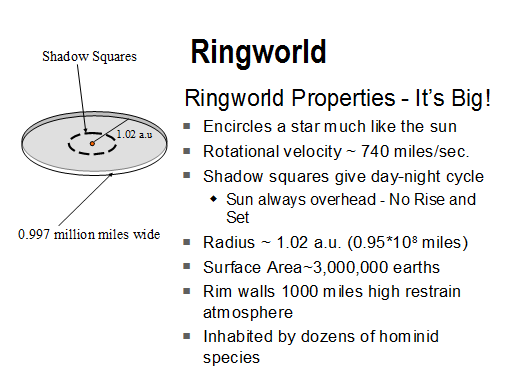
NOTES:
I'm sure all of you are familiar with Niven's Ringworld, which he described as halfway between a normal planet and a Dyson sphere (Freeman Dyson, the mathematician who established that Feynman's and Schwinger's approaches to quantum electrodynamics were equivalent, suggested in 1959 that a technological species would eventually need all its sun's energy, and that it could get that energy by surrounding the sun with an immense number of planetoids, so that all the light from the sun was captured. Nowadays, people usually use the phrase to mean a solid sphere surrounding the sun). Ringworld is a less audacious concept than a Dyson sphere but it's still so immense a construct that most minds boggle even after quite a lengthy exposure to the idea. Basically, Ringworld is a huge ribbon circling a star; the inside of the ribbon is habitable. An example of the scale of the Ringworld is this: on Ringworld, there is an ocean large enough that a full scale map of earth is a tiny archipelago separated from other such island groups by an ocean voyage of up to a half million miles, or twice the distance from the earth to the moon.
So what's it like on Ringworld? It's a big place - the surface area is about 3 million times the Earth's. Shadow squares (see diagram) provide a day-night cycle of 30 hours, but when the sun is not shadowed, it's always directly overhead - it never rises or sets. Unlike in a Dyson sphere you can see the stars, but the biggest feature of the sky is the Arch, the other side of the Ring from where you are. Somehow, the Ringworld became inhabited by primates half a million years ago or so and now there are dozens of species of human-like but non-human creatures filling the Ring, some intelligent, some not.
In several places in the book, the tangential velocity is given as 770 miles/sec, but 740 miles/sec gives the right answer for the given period of rotation and the given surface gravity. This difference doesn't really affect much though, except for trivia contests I suppose.
